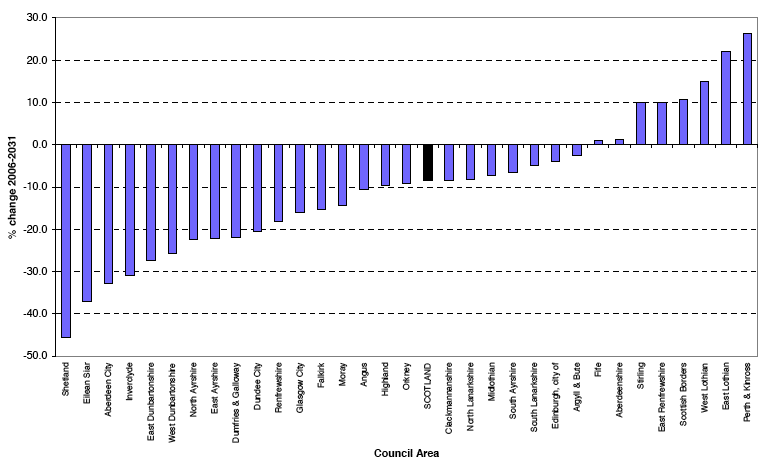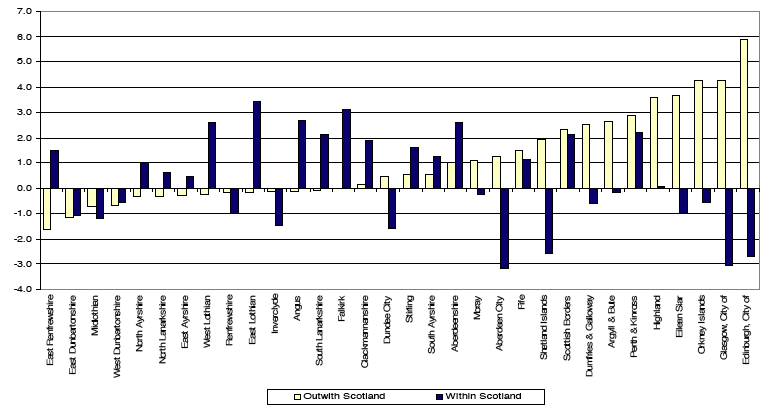
5.1.1 The results are produced by the demographic component method using a single year projection model (see paragraph 5.1.2). That is, a projection is made by sex and single year of age (up to age 90 & over) for each future year. This is done for arithmetical convenience and should not be taken to imply that reliable projections can be made in such detail. However, it provides "building blocks" which users can aggregate into age-groups of their choice for the years in which they are interested. For example, the production of results in standard five-year age groups (0-4, 5-9, 10-14, etc.) does not help the education planner wishing to know the size of the future population of secondary school age. Also, as some planning is done on a "rolling" basis (for example 10 years from a moving base date), it is useful to be able to provide a projection for any future year rather than just selected years.
5.1.2 The projection starts with the population estimates for the base year, disaggregated by single year of age, sex, and area. This base population is then projected one year ahead. First, an estimate of the numbers surviving to be one year older is made by applying a series of mortality rates to give the numbers of deaths, and hence survivors, at each age. The numbers of live births in the year are produced, using fertility rates in combination with the female populations of child bearing age; and an allowance is made for infant mortality. Lastly, the expected number and age/sex structure of people entering and leaving the area is taken into account in order to cover changes in the population due to migration. These three components of population change, together with the starting population, combine to form a projection of the population one year from the base date. The process can be repeated as often as required. For each year of the projection period, it is necessary to make assumptions about the future fertility rates (to give the number of births), mortality rates (for deaths) and migration. The following paragraphs describe the base population, the small changes made to the software and the method compared with previous projections as well as the assumptions made in the new projections.
5.2.1 The Registrar General's mid-2006 population estimates were used as the base population. These were first published in April 2007 but were revised in July 2007 and it is these revised figures which are used as the base population. These cover all persons usually resident in each area, whatever their nationality. Usual residents temporarily away from home are included, but visitors are excluded. Students are taken to be resident at their term-time address. Members of HM and non-UK Armed Forces stationed in Scotland are included; HM forces stationed outside Scotland are excluded. Population figures relate to 30 June 2006 and ages relate to age last birthday.
5.3 Projections software system and other small method changes
5.3.1 The software used to produce the population projections is an in-house MS Excel macro system which has been developed over a number of years. The system runs on 36 "building bricks" – areas which aggregate to both council and NHS board areas.
5.4.1 The projected number of births was obtained by applying age specific fertility2 rates to the numbers of women at each childbearing age, for each year of the projection period. In determining the fertility rates used in the national projections for Scotland, assumptions were made about the average completed family size for successive generations of women. This measure tends to be more stable over time than fertility rates for specific years (so-called period fertility rates), because of generational differences in the timing of having families. It was assumed that the average completed family size will continue to decline from around 1.90 children per woman for those born in the late 1950s and now reaching the end of their childbearing lives, before levelling off at 1.65 for those born in the 1990s and later. The number of births is expected to continue the recently-observed rise before peaking at around 57,600 in 2011 and falling to around 50,300 in 2031. The resultant age specific fertility rates assumed for Scotland as a whole are given in Annex A. More information on the fertility assumptions for Scotland can be found in Annex A to the publication "Projected Population of Scotland (2006-based)" on the General Register Office for Scotland’s website.
5.4.2 The projected number of births by administrative area is shown in Table 4. The percentage change in the number of projected births between 2006 and 2031 by council area is also shown in Figure 11.
Figure 11 Projected percentage change in births (2006-based), by council area, 2006-2031

5.4.3 For local areas, the assumed national fertility rates have been adjusted to take account of local variations observed in the five year period preceding the projection. The local scaling factors used to adjust the national rates are given in Annex C.
5.5.1 The projected number of deaths each year was calculated by applying mortality rates by age and sex to the appropriate sub-populations. The national rates for the first year of the projections, 2006-07, were based on autumn 2007 estimates of the numbers of deaths at each age in that period. The mortality rates for later years were based on long-term trends before 2006. Future improvements in mortality rates are based on the trend observed in the period 1961 to 2005. It is assumed that annual rates of reduction in mortality rates will tend toward a common reduction at each age of 1 percent a year by 2031. Thereafter, the mortality improvement is assumed to continue at this rate. In line with long-term trends, it has been assumed that the mortality rates for Scotland will continue to be higher at most ages than those for England and Wales.
5.5.2 Based on these rates, expectation of life at birth is projected to increase from 74.5 years in 2005 to 80.4 in 2031 for men; and from 79.5 in 2005 to 84.8 in 2031 for women. The national mortality rates are shown, for selected ages and for selected years of the projection, in Annex B.
5.5.3 Similar to the fertility assumptions for local areas, the assumed national mortality rates have been adjusted to take account of local variations observed in the five year period preceding the projections. As recommended by the Population Projections Working Group (PPWG) different scaling factors were used for different age groups to reflect the fact that the variation in mortality rates between areas will itself vary between age groups. Rather than using a single scaling factor for men and another for women different scaling factors were used for age groups 0-59, 60-79 and 80+ and for men and women meaning that up to 6 scaling factors were used for each area. In some smaller areas, fewer scaling factors were used as the small numbers of deaths were subject to large fluctuations. The local scaling factors used to adjust the national rates are shown in Annex C. More information on the mortality assumptions for Scotland can be found in Annex B to the publication "Projected Population of Scotland (2006-based)" on the General Register Office for Scotland’s website.
5.6.1 Assumptions about future levels of migration to and from Scotland were based on analysis of trends in civilian migration to and from the UK and between the four constituent countries of the UK. Reflecting the most recent information, the principal projection assumes net in-migration of 8,500 from 2012-13 onwards; the previous sub-national projections, assumed net in-migration of 4,000 per year for the long-term. In the first six years of the new projection higher net inflows are assumed, reflecting these recent trends. It is assumed that in the short-term there will be a net inflow of 20,500 migrants to Scotland in 2006-2007, 16,000 in 2007-2008, 14,000 in 2008-2009, 11,500 in 2009-2010, 10,500 in 2010-2011 and 9,500 in 2011-2012 before the level drops to an assumed net inflow of 8,500 for the rest of the projection period. This reflects recent increases in the number of people migrating to Scotland, after many years when net out-migration was the norm.
5.6.2 For the high migration variant projection net in-migration of 17,000 is assumed from 2012-13 onward with higher levels (starting at 24,750 in 2006-07) assumed for the first six years.
5.6.3 More information on the migration assumptions for Scotland can be found in Annex C to the publication "Projected Population of Scotland (2006-based)" on the General Register Office for Scotland’s website.
5.6.4 The net migration assumptions for local areas used in the principal projection were made after consultation with local authorities. The initial long term assumptions were calculated by taking 5 year averages of in and out migration between councils within Scotland and between councils and other countries. These averages were scaled to match the migration assumptions used in the national projections. The short term assumptions were calculated by moving between the 2005/06 migration estimate and the long term assumption at the same rate as the national figures changed. The assumptions for each area are shown in Annex D. It is important to remember that the local assumptions have to match the totals used in the national projections and that for the longer term, migration assumptions are highly speculative.
5.6.5 For the high migration variant projection a similar method is used but this time the local assumptions have to match with the higher totals used in the national variant projection. This higher net inflow only affects moves to and from outwith Scotland i.e. it has no impact on moves within Scotland. Migration to and from an area is made up of a mixture of within Scotland and outwith Scotland migration and the extent to which a particular area experiences more of one or the other type of migration will determine the impact of the variant projection. Figure 12 shows the council areas which have gained large number of migrants from other countries over the past 5 years and which are therefore most affected by the high migration variant. These include Edinburgh, Glasgow City, Orkney, Eilean Siar and Highland. The trends in net migration for the previous five years are shown in Annex F. The high migration variant assumptions for each area are shown in Annex E.
Figure 12 Migration to and from outwith Scotland and to and from other council areas within Scotland

5.6.6 Council and NHS board area specific age/sex distributions have been assumed for the in- and out- migrant flows using information on movement of patients from the National Health Service Central Register (NHSCR) observed in the previous three years and the Community Health Index (CHI), again over the previous 3 years. For the first time the CHI has been used in place of census data. These distributions have been made consistent with the age/sex distribution used for Scotland in the national projection.